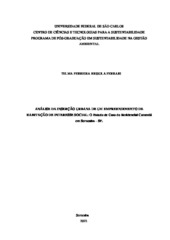Análise da inserção urbana de um empreendimento de habitação de interesse social: o estudo de caso do residencial Carandá em Sorocaba – SP
Abstract
The reproduction of the urban space reflects the performance of multiple actors with different interests; most of the time, the economic nature stands out to the detriment of the social-environmental. In Brazil, one of the urbanization problems is related to its segregating nature, implying the unequal access of diverse social extracts to the cities, their services, and urban equipment; it also reflects on the housing deficit rates. In 2009, to catch up with this demand, the Federal Program, Programa Federal Minha Casa Minha Vida (PMCMV), was implemented. One of its modalities constituted popular housing production through financial subsidies and the performance of construction companies. However, if, on the one hand, the PMCMV generated staggering numbers of houses, on the other hand, the market logic overlaps the idea of housing politics, and it was not able to transform the inequalities arising from the exclusionary urbanization. As a result, great housing came true outlying the city's fringes, where land is cheaper, there are no markets nor services, and urban mobility is harmed. In Sorocaba – SP, the Jardim Carandá residential area is shown as an example of everything said, considering that for its viability, it was necessary to enlarge many urban services, representing a high social cost for the city not necessarily supplying the residents' demands. In this scenery, the analysis of Carandá Urban Insertion, which considers attributes such as its localization, access to urban infrastructure, and urban fluidity, is shown as an asset to illustrate the issues previously commented on and demonstrate that constructing houses means constructing cities. It also makes us reflect on the role of housing politics and land management, represented by the Directing Plans, in reproducing the urban spread. Finally, it invites us to rethink what kind of cities we are building for the next generations by reproducing an urbanization model that is already showing itself to be unsustainable.
Collections
The following license files are associated with this item:

